This article was co-authored by Trudi Griffin, LPC, MS. Trudi Griffin is a Licensed Professional Counselor in Wisconsin specializing in Addictions and Mental Health. She provides therapy to people who struggle with addictions, mental health, and trauma in community health settings and private practice. She received her MS in Clinical Mental Health Counseling from Marquette University in 2011.
There are 33 references cited in this article, which can be found at the bottom of the page.
This article has been viewed 233,215 times.
Schizophrenia is a complex clinical diagnosis with a very controversial history. You cannot diagnose yourself with schizophrenia. You should consult with a trained clinician, such as a psychiatrist or clinical psychologist. Only a trained mental health professional can make an accurate diagnosis of schizophrenia. However, if you are worried that you might have schizophrenia, you can learn some criteria that can help you understand what schizophrenia looks like and whether you are at risk.
Identifying Characteristic Symptoms
-
1Recognize characteristic symptoms (Criterion A). In order to diagnose schizophrenia, a mental health clinician will first look for symptoms in five “domains”: delusions, hallucinations, disorganized speech and thinking, grossly disorganized or abnormal motor behavior (including catatonia), and negative symptoms (symptoms that reflect a reduction in behavior).[1] [2]
- You must have at least 2 (or more) of these symptoms. Each must be present for a significant portion of time during a 1-month period (less if the symptoms have been treated). At least 1 of the minimum 2 symptoms must be delusions, hallucinations, or disorganized speech.
-
2Consider whether you could be having delusions. Delusions are irrational beliefs that often emerge as a response to a perceived threat that is largely or entirely unconfirmed by other people. Delusions are maintained despite evidence that they are not true.[3]
- There’s a difference between delusions and suspicions. Many people will occasionally have irrational suspicions, such as believing a co-worker is “out to get them” or that they’re having an “unlucky streak.” The difference is whether these beliefs cause you distress or make it hard to function.
- For example, if you are so convinced that the government is spying on you that you refuse to leave your house to go to work or school, that is a sign that your belief is causing dysfunction in your life.[4]
- Delusions may sometimes be bizarre, such as believing you’re an animal or a supernatural being. If you find yourself convinced of something beyond the usual realms of possibility, this could be a sign of delusions (but is certainly not the only possibility).
Advertisement -
3Think about whether you’re experiencing hallucinations. Hallucinations are sensory experiences that seem real, but are created in your mind.[5] Common hallucinations may be auditory (things you hear), visual (things you see), olfactory (things you smell), or tactile (things you feel, such as the creepy-crawlies on your skin). Hallucinations may affect any of your senses.[6]
- For example, consider whether you frequently experience the sensation of things crawling over your body. Do you hear voices when no one is around? Do you see things that “shouldn’t” be there, or that no one else sees?
-
4Think about your religious beliefs and cultural norms. Having a belief that others may see as “strange” does not mean you’re having delusions. Similarly, seeing things that others may not is not always a dangerous hallucination. Beliefs can only be judged as “delusional” or dangerous in accordance with local cultural and religious norms. Beliefs and visions are usually only considered signs of psychosis or schizophrenia if they create unwanted or dysfunctional obstacles in your daily life.
- For example, a belief that wicked actions will be punished by “fate” or “karma” might seem delusional to some cultures but not to others.[7]
- What count as hallucinations are also related to cultural norms. For example, children in many cultures can experience auditory or visual hallucinations -- such as hearing the voice of a deceased relative -- without being considered psychotic, and without developing psychosis later in life.[8] [9]
- Highly religious people may be more likely to see or hear some things, such as hearing the voice of their deity or seeing an angel. Many belief systems accept these experiences as genuine and productive, even something to be sought after. Unless the experience distresses or endangers the person or others, these visions are not generally a cause for concern.[10]
-
5Consider whether your speech and thinking are disorganized. Disorganized speech and thinking are basically what they sound like. It may be difficult for you to answer questions effectively or fully. Answers may be tangential, fragmented, or incomplete. In many cases, disorganized speech is accompanied by the inability or unwillingness to sustain eye contact or use non-verbal communication, such as gestures or other body language.[11] You may need the help of others to know whether this is happening.
- In the most severe cases, speech may be “word salad,” strings of words or ideas that are not related and do not make sense to listeners.[12]
- As with other symptoms in this section, you must consider “disorganized” speech and thinking must be considered within your own social and cultural context.[13] For example, some religious beliefs hold that individuals will speak in strange or unintelligible language when in contact with a religious figure. Furthermore, narratives are structured very differently across cultures, so stories told by people in one culture may appear “weird” or “disorganized” to an outsider who is unfamiliar with those cultural norms and traditions.[14]
- Your language is likely to be “disorganized” only if others who are familiar with your religious and cultural norms cannot understand or interpret it (or it occurs in situations in which your language “should” be understandable).
-
6Identify grossly disorganized or catatonic behavior. Grossly disorganized or catatonic behavior can manifest in a number of ways. You may feel unfocused, which makes it hard to perform even simple tasks such as washing your hands. You may feel agitated, silly, or excited in unpredictable ways. “Abnormal” motor behavior may be inappropriate, unfocused, excessive, or purposeless. For example, you might frantically wave your hands around or adopt a strange posture.[15] [16]
- Catatonia is another sign of abnormal motor behavior. In severe cases of schizophrenia, you may remain still and silent for days on end. Catatonic individuals will not respond to external stimuli, such as conversation or even physical prompting, such as touching or poking.[17]
-
7Think about whether you have experienced a loss of function. Negative symptoms are symptoms that show a “decrease” or reduction in “normal” behaviors. For example, a decrease in emotional range or expression would be a “negative symptom.” So would a loss of interest in things you used to enjoy, or a lack of motivation to do things.[18]
- Negative symptoms may also be cognitive, such as difficulty concentrating. These cognitive symptoms are usually more self-destructive and more obvious to others than the inattentiveness or concentration trouble typically seen in people diagnosed with ADHD.[19]
- Unlike ADD or ADHD, these cognitive difficulties will occur across most types of situations that you encounter, and they cause significant problems for you in many areas of your life.
Considering Your Life with Others
-
1Consider whether your occupation or social life is functioning (Criterion B). The second criterion for a schizophrenia diagnosis is “social/occupational dysfunction.” This dysfunction must be present for a significant portion of the time since you began displaying symptoms. Many conditions can cause dysfunction in your work and social life, so even if you’re experiencing trouble in one or more of these areas, it doesn’t necessarily mean you have schizophrenia. One or more areas of “major” functioning must be impaired:[20]
- Work/Academics
- Interpersonal relations
- Self-care
-
2Think about how you handle your job. One of the criteria for “dysfunction” is whether you are able to fulfill the requirements of your job. If you’re a full-time student, your ability to perform in school could be considered. Consider the following:
- Do you feel psychologically able to leave the house to go to work or school?
- Have you had a hard time coming in on time or showing up regularly?
- Are there parts of your work that you now feel afraid to do?
- If you are a student, is your academic performance suffering?
-
3Reflect on your relationships with other people. This should be considered in light of what is normal for you. If you’ve always been a reserved person, not wanting to socialize isn’t necessarily a sign of dysfunction. However, if you’ve noticed your behaviors and motivations change to things that aren’t “normal” for you, this could be something to speak with a mental health professional about.
- Do you enjoy the same relationships you used to?
- Do you enjoy socializing in the way you used to?
- Do you feel like talking with others significantly less than you used to?
- Do you feel afraid or intensely worried about interacting with others?
- Do you feel like you're being persecuted by others, or that others have ulterior motives toward you?
-
4Think about your self-care behaviors. “Self-care” refers to your ability to take care of yourself and remain healthy and functional. This should also be judged within the realm of “normal for you.” So, for example, if you usually work out 2-3 times per week but haven’t felt like going in 3 months, this could be a sign of disturbance. The following behaviors are also signs of lapsed self-care:
- You have started or increased abusing substances such as alcohol or drugs
- You don’t sleep well, or your sleep cycle varies widely (e.g., 2 hours one night, 14 hours the next, etc.)
- You don’t “feel” as much, or you feel “flat”
- Your hygiene has gotten worse
- You don’t take care of your living space
Thinking About Other Possibilities
-
1Consider for how long symptoms have been appearing (Criterion C). To diagnose schizophrenia, a mental health professional will ask you how long the disturbances and symptoms have been going on. To qualify for a diagnosis of schizophrenia, the disturbance must have been in effect for at least 6 months.[21]
- This period must include at least 1 month of “active-phase” symptoms from Part 1 (Criterion A), although the 1-month requirement may be less if symptoms have been treated.
- This 6-month period may also include periods of “prodromal” or residual symptoms. During these periods, the symptoms may be less extreme (i.e., “attenuated”) or you may experience only “negative symptoms” such as feeling less emotion or not wanting to do anything.
-
2Rule out other possible culprit illnesses (Criterion D). Schizoaffective disorder and depressive or bipolar disorder with psychotic features can cause symptoms very similar to some of those in schizophrenia. Other illnesses or physical traumas, such as strokes and tumors, can cause psychotic symptoms.[22] This is why it is crucial to seek help from a trained mental health clinician. You cannot make these distinctions on your own.[23]
- Your clinician will ask if you have had major depressive or manic episodes at the same time as your “active-phase” symptoms.
- A major depressive episode involves at least one of the following for a period of at least 2 weeks: depressed mood or loss of interest or pleasure in things you used to enjoy. It will also include other regular or near-constant symptoms in that time frame, such as significant weight changes, disruption in sleeping patterns, fatigue, agitation or slowing down, feelings of guilt or worthlessness, trouble concentrating and thinking, or recurrent thoughts about death. A trained mental health professional will help you determine whether you have experienced a major depressive episode.
- A manic episode is a distinct period of time (usually at least 1 week) when you experience an abnormally elevated, irritated, or expansive mood. You will also display at least three other symptoms, such as decreased need for sleep, inflated ideas of yourself, flighty or scattered thoughts, distractibility, increased involvement in goal-directed activities, or an excessive involvement in pleasurable activities, especially those with a high risk or potential for negative consequences. A trained mental health professional will help you determine whether you have experienced a manic episode.
- You will also be asked how long these mood episodes lasted during your “active-phase” symptoms. If your mood episodes were brief in comparison to how long the active and residual periods lasted, this may be a sign of schizophrenia.
-
3Rule out substance use (Criterion E). Substance use, such as drugs or alcohol, can cause symptoms similar to those in schizophrenia. When diagnosing you, your clinician will make sure that the disturbances and symptoms you’re experiencing are not because of the “direct physiological effects” of a substance, such as an illegal drug or medication.[24]
- Even legal, prescribed medications can cause side effects such as hallucinations. It’s important for a trained clinician to diagnose you so that s/he can distinguish between side effects from a substance and symptoms of an illness.
- Substance use disorders (commonly known as “substance abuse”) commonly co-occur with schizophrenia. Many people suffering from schizophrenia may attempt to “self-medicate” their symptoms with medication, alcohol, and drugs. Your mental health professional will help you determine if you have a substance use disorder.[25]
-
4Consider the relationship to Global Developmental Delay or Autism Spectrum Disorder. This is another element that must be handled by a trained clinician. Global Developmental Delay or Autism Spectrum Disorder may cause some symptoms that are similar to those in schizophrenia.[26]
- If there is a history of autism spectrum disorder or other communication disorders that begin in childhood, a diagnosis of schizophrenia will only be made if there are prominent delusions or hallucinations present.
-
5Understand that these criteria do not “guarantee” that you have schizophrenia. The criteria for schizophrenia and many other psychiatric diagnoses are what as known as polythetic. This means that there are many ways of interpreting the symptoms, and different ways the symptoms may combine and appear to others. Diagnosing schizophrenia can be difficult even for trained professionals.[27]
- It is also possible, as mentioned before, that your symptoms could be the result of another trauma, illness, or disorder. You must seek professional medical and mental health help to properly diagnose any disorder or disease.
- Cultural norms and local and personal idiosyncrasies in thought and speech can affect whether your behavior appears “normal” to others.[28]
Taking Actions
-
1Ask your friends and family for help. It can be hard to identify some things, such as delusions, in yourself. Ask your family and friends to help you figure out whether you are displaying these symptoms.
-
2Keep a journal. Write down when you think you may be having hallucinations or other symptoms. Keep track of what happened just before or during these episodes. This will help you figure out how commonly these things occur. It will also help when you consult a professional for diagnosis.
-
3Take notice of unusual behaviors. Schizophrenia, especially in teenagers, can creep up slowly over a period of 6-9 months. If you notice that you're behaving differently and don't know why, talk with a mental health professional. Don’t just “write off” different behaviors as nothing, especially if they are very unusual for you or they’re causing you distress or dysfunction. These changes are signs that something is wrong. That something may not be schizophrenia, but it's important to consider.
-
4Take a screening test. An online test can't tell you if you have schizophrenia. Only a trained clinician can make an accurate diagnosis after tests, examinations, and interviews with you. However, a trustworthy screening quiz can help you figure out what symptoms you may have and whether they are likely to suggest schizophrenia.[29]
-
5Talk with a professional. If you're worried that you might have schizophrenia, talk with your physician or therapist. While they do not usually have the resources to diagnose schizophrenia, a general practitioner or therapist can help you understand more about what schizophrenia is and whether you should see a psychiatrist.
- Your physician can also help you rule out other causes of symptoms, such as injury or illness.
Knowing Who’s At Risk
-
1Understand that the causes of schizophrenia are still being investigated. While researchers have identified some correlations between certain factors and the development or triggering of schizophrenia, the exact cause of schizophrenia is still unknown.[32]
- Discuss your family history and medical background with your doctor or mental health provider.
-
2Consider whether you have relatives with schizophrenia or similar disorders. Schizophrenia is at least partially genetic. Your risk for developing schizophrenia is about 10% higher if you have at least one “first-degree” family member (e.g., parent, sibling) with the disorder.[33]
- If you have an identical twin with schizophrenia, or if both of your parents have been diagnosed with schizophrenia, your risk of developing it yourself is more like 40-65%.
- However, about 60% of people who are diagnosed with schizophrenia do not have close relatives who have schizophrenia.
- If another family member -- or you -- has another disorder similar to schizophrenia, such as a delusional disorder, you may be at higher risk for developing schizophrenia.[34]
-
3Determine if you were exposed to certain things while in the womb. Infants who are exposed to viruses, toxins, or malnutrition while in the womb may be more likely to develop schizophrenia. This is especially true if the exposure happened in the first and second trimesters.[35]
- Infants who experience a lack of oxygen during birth may also be more likely to develop schizophrenia.
- Infants who are born during a time of famine are more than twice as likely to develop schizophrenia. This may be because malnourished mothers cannot get enough nutrients during their pregnancy.[36]
-
4Think about your father’s age. Some studies have shown a correlation between the age of the father and the risk for developing schizophrenia. One study showed that children whose fathers who were 50 years old or older when they were born were 3 times as likely to develop schizophrenia as those whose fathers were 25 years old or younger.[37]
- It is thought that this may be because the older the father is, the more likely his sperm is to develop genetic mutations.
Warnings
- Do not self-medicate your symptoms using medication, alcohol, or drugs. This will make them worse and could potentially harm or kill you.⧼thumbs_response⧽
- Like any other illness, the sooner you get a diagnosis and seek treatment, the better chance you have of surviving and leading a good life.⧼thumbs_response⧽
- This article is not intended to provide medical advice and is for general purposes only. If you need help, please consult with your local physician.⧼thumbs_response⧽
- This article is designed to give you some clues about whether you may have schizophrenia, but it is not intended to serve as a diagnosis. Until a mental health professional (clinical psychologist or psychiatrist) can confirm the diagnosis, do not assume you have schizophrenia.⧼thumbs_response⧽
- There is no one-size-fits-all “cure” for schizophrenia. Be wary of treatments or people who try to tell you they can “cure” you, especially if they promise it will be quick and easy.[38]⧼thumbs_response⧽
References
- ↑ http://dsm.psychiatryonline.org/doi/full/10.1176/appi.books.9780890425596.dsm02
- ↑ Tandon, R., Gaebel, W., Barch, D. M., Bustillo, J., Gur, R. E., Heckers, S., … Carpenter, W. (2013). Definition and description of schizophrenia in the DSM-5. Schizophrenia Research, 150(1), 3–10
- ↑ Miyazono, K. (2015). Delusions as harmful malfunctioning beliefs. Consciousness and Cognition, 33, 561–573.
- ↑ Seeman, M. V. (2015). On Delusion Formation. Canadian Journal of Psychiatry, 60(2), 87–90.
- ↑ Teeple, R. C., Caplan, J. P., & Stern, T. A. (2009). Visual Hallucinations: Differential Diagnosis and Treatment. Primary Care Companion to The Journal of Clinical Psychiatry, 11(1), 26–32.
- ↑ http://www.healthline.com/symptom/hallucinations
- ↑ Bhugra, D., & Kalra, G. (2010, July). Cross-Cultural Psychiatry: Context and Issues. Journal of Pakistan Psychiatric Society, pp. 51–54.
- ↑ Liester, M. B. (1998). Toward a new definition of hallucination. American Journal of Orthopsychiatry, 68(2), 305–312.
- ↑ Mertin, P., Niamh. (2013). High emotional arousal and failures in reality monitoring: Pathways to auditory hallucinations in non-psychotic children? Scandinavian Journal of Psychology, 54(2), 102–106.
- ↑ Reed, P., & Clarke, N. (2014). Effect of religious context on the content of visual hallucinations in individuals high in religiosity. Psychiatry Research, 215, 594–598
- ↑ Bergman, H. F., Preisler, G., & Werbart, A. (2006). Communicating with patients with schizophrenia: characteristics of well functioning and poorly functioning communication. Qualitative Research in Psychology, 3(2), 121–146.
- ↑ https://www.mayoclinic.org/diseases-conditions/schizophrenia/symptoms-causes/syc-20354443
- ↑ Scull, A. (2014). Cultural Sociology of Mental Illness: An A-to-Z Guide. SAGE Publications
- ↑ American Psychiatric Association. (2013). Diagnostic and Statistical Manual of Mental Disorders. American Psychiatric Association, p. 103.
- ↑ https://www.mayoclinic.org/diseases-conditions/schizophrenia/symptoms-causes/syc-20354443
- ↑ Strauss, G. P., Morra, L. F., Sullivan, S. K., & Gold, J. M. (2015). The role of low cognitive effort and negative symptoms in neuropsychological impairment in schizophrenia. Neuropsychology, 29(2), 282–291.
- ↑ Sixt, B., van Aaken, C., Hennighausen, K., Fleischhaker, C., & Schulz, E. (2013). Severe catatonic schizophrenia in a 17-year-old adolescent female. In N. Boutros & N. (Ed) Boutros (Eds.), The international psychiatry and behavioral neurosciences yearbook - 2012, Vol 2. (pp. 55–63). Hauppauge, NY, US: Nova Biomedical Books.
- ↑ http://emedicine.medscape.com/article/288259-overview
- ↑ Freedman, J. L. Z. (2012). Pseudo-ADHD in a Case of First-Episode Schizophrenia: Diagnostic and Treatment. Harvard Review of Psychiatry (Taylor & Francis Ltd), 20(6), 309–317.
- ↑ Tandon, R., Gaebel, W., Barch, D. M., Bustillo, J., Gur, R. E., Heckers, S., … Carpenter, W. (2013). Definition and description of schizophrenia in the DSM-5. Schizophrenia Research, 150(1), 3–10
- ↑ Tandon, R., Gaebel, W., Barch, D. M., Bustillo, J., Gur, R. E., Heckers, S., … Carpenter, W. (2013). Definition and description of schizophrenia in the DSM-5. Schizophrenia Research, 150(1), 3–10
- ↑ http://www.health.am/psy/more/misdiagnosis-or-other-disorders-that-may-look-like-schizophrenia/
- ↑ Tandon, R., Gaebel, W., Barch, D. M., Bustillo, J., Gur, R. E., Heckers, S., … Carpenter, W. (2013). Definition and description of schizophrenia in the DSM-5. Schizophrenia Research, 150(1), 3–10
- ↑ Tandon, R., Gaebel, W., Barch, D. M., Bustillo, J., Gur, R. E., Heckers, S., … Carpenter, W. (2013). Definition and description of schizophrenia in the DSM-5. Schizophrenia Research, 150(1), 3–10
- ↑ Gouzoulis-Mayfrank, E., & Walter, M. (2015). Schizophrenia and addiction. In G. Dom, F. Moggi, G. (Ed) Dom, & F. (Ed) Moggi (Eds.), Co-occurring addictive and psychiatric disorders: A practice-based handbook from a European perspective. (pp. 75–86). New York, NY, US: Springer-Verlag Publishing.
- ↑ Tandon, R., Gaebel, W., Barch, D. M., Bustillo, J., Gur, R. E., Heckers, S., … Carpenter, W. (2013). Definition and description of schizophrenia in the DSM-5. Schizophrenia Research, 150(1), 3–10
- ↑ Olbert, C. M., Gala, G. J., & Tupler, L. A. (2014). Quantifying heterogeneity attributable to polythetic diagnostic criteria: Theoretical framework and empirical application. Journal of Abnormal Psychology, 123(2), 452–462.
- ↑ Rashed, M. A. (2013). Psychiatric Judgments Across Cultural Contexts: Relativist, Clinical-Ethnographic, and Universalist-Scientific Perspectives. Journal of Medicine & Philosophy, 38(2), 128–148.
- ↑ http://www.mayoclinic.org/diseases-conditions/schizophrenia/basics/tests-diagnosis/con-20021077
- ↑ http://counsellingresource.com/lib/quizzes/misc-tests/schizophrenia-test/
- ↑ http://psychcentral.com/quizzes/schizophrenia.htm
- ↑ https://www.mayoclinic.org/diseases-conditions/schizophrenia/symptoms-causes/syc-20354443
- ↑ http://www.ncbi.nlm.nih.gov/pubmed/10719141
- ↑ http://www.webmd.com/schizophrenia/tc/schizophrenia-what-increases-your-risk
- ↑ https://www.mayoclinic.org/diseases-conditions/schizophrenia/symptoms-causes/syc-20354443
- ↑ http://www.nytimes.com/health/guides/disease/schizophrenia/risk-factors.html
- ↑ http://www.nytimes.com/health/guides/disease/schizophrenia/risk-factors.html
- ↑ Luhrmann, T. M. (2012). Beyond the brain: in the 1990s, scientists declared that schizophrenia and other psychiatric illnesses were pure brain disorders that would eventually yield to drugs. now they are recognizing that social factors are among the causes, and must be part of the cure. The Wilson Quarterly, (3).
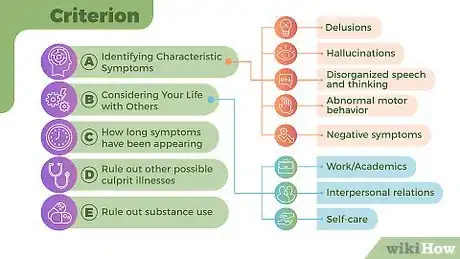
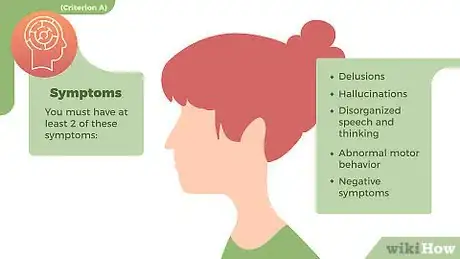

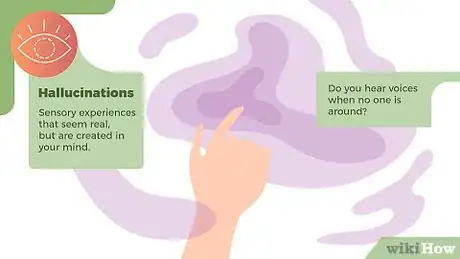
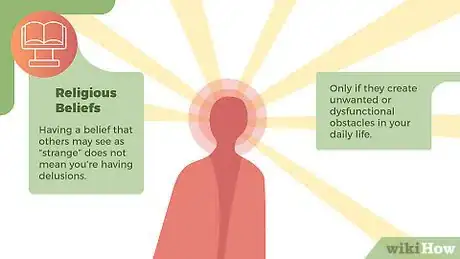
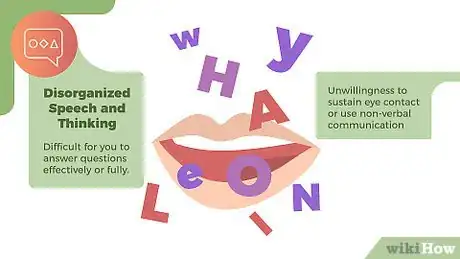
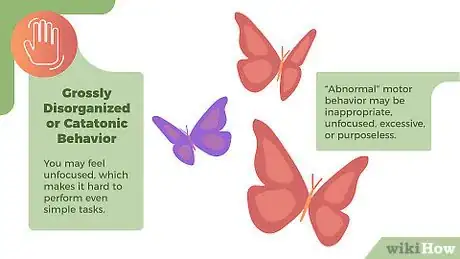
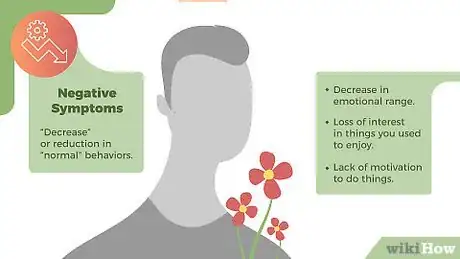
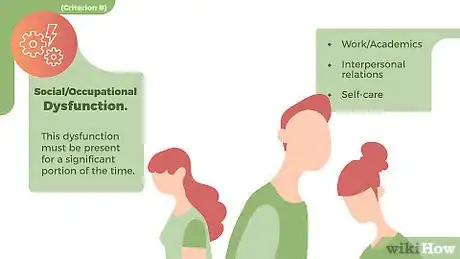

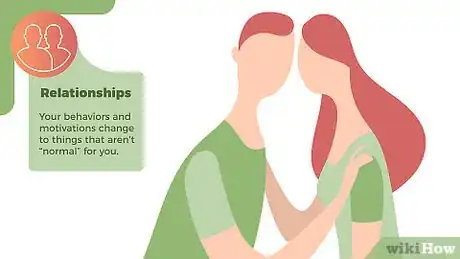
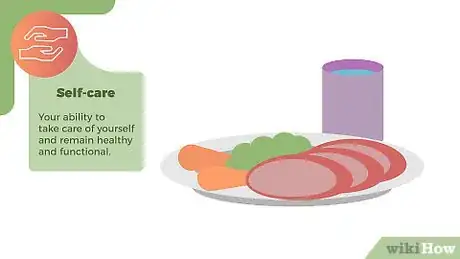


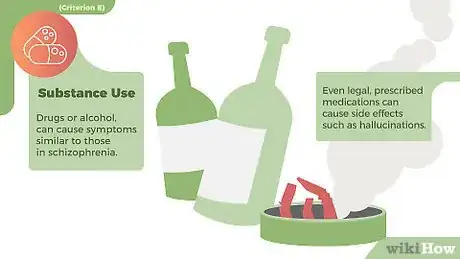
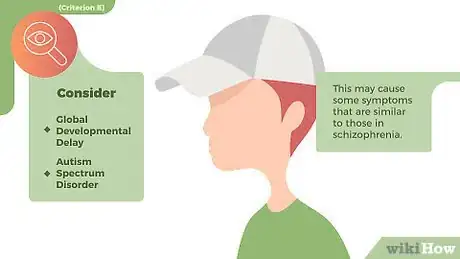

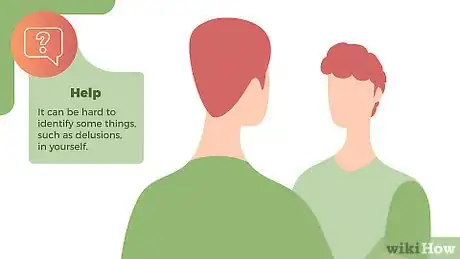

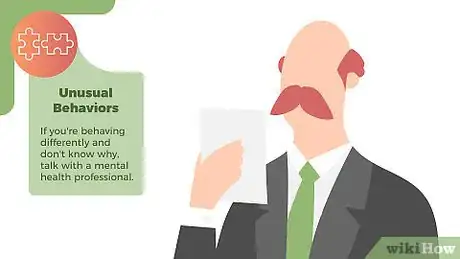
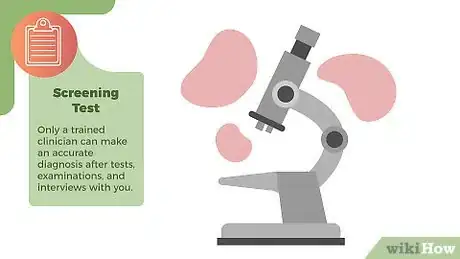

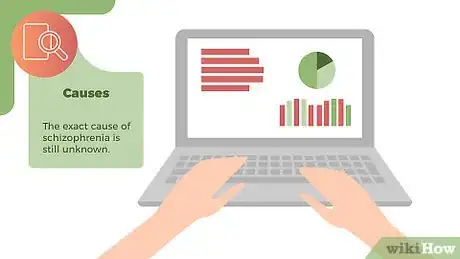
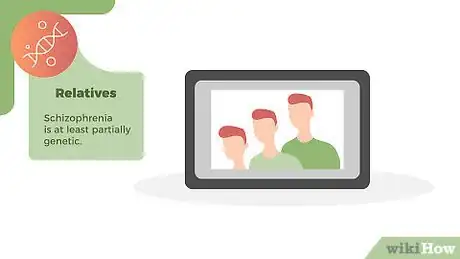

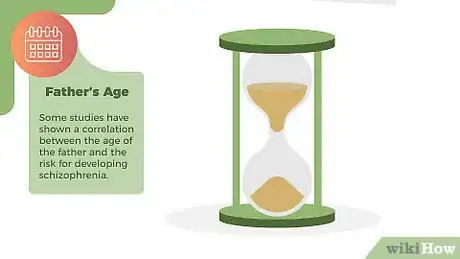
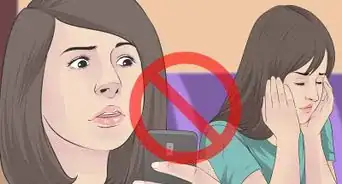

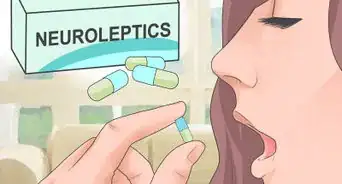

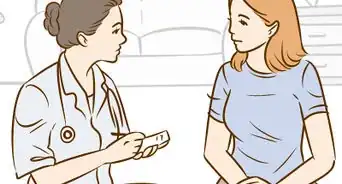

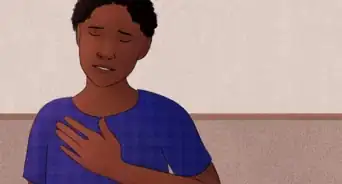
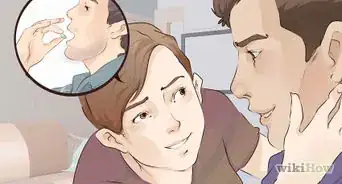

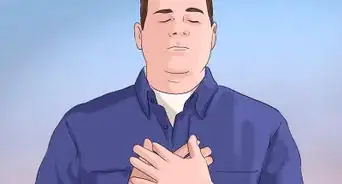

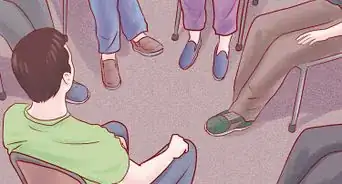








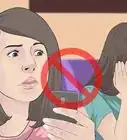






































Medical Disclaimer
The content of this article is not intended to be a substitute for professional medical advice, examination, diagnosis, or treatment. You should always contact your doctor or other qualified healthcare professional before starting, changing, or stopping any kind of health treatment.
Read More...